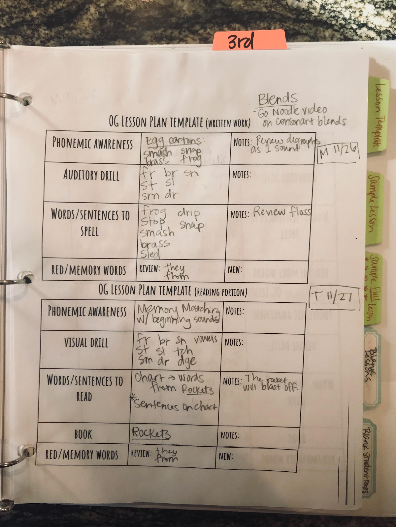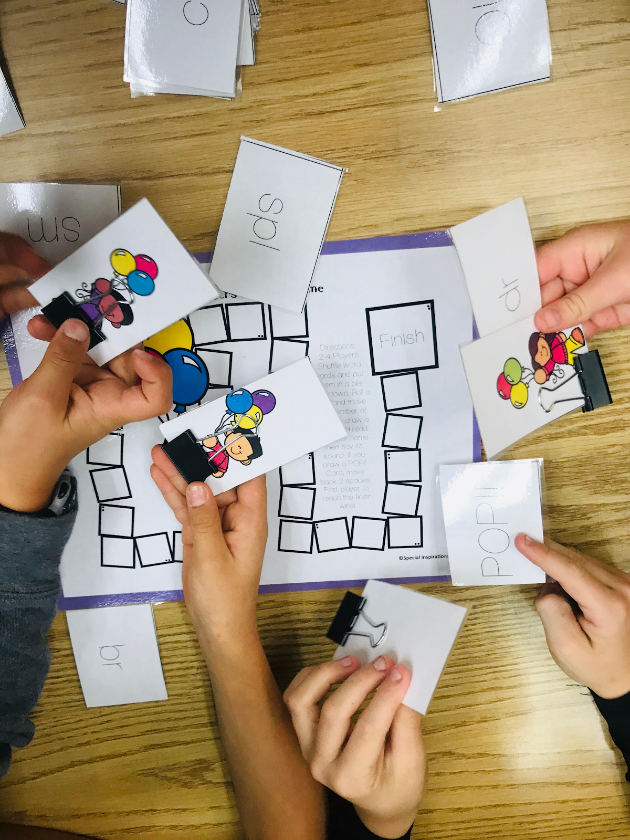Happy New Year!! Today's guest post features an amazing SPED teacher, Allison from @sweetlysped, who implements the Orton-Gillingham Approach into her classroom every day. She has many fabulous ideas and insights on how easy it can be to start using OG in your classroom!
Hi! Hello! My name is Allison Rios and I am a resource teacher for kindergarten-3rd grade students at a public school in the suburbs of Denver. My student base primarily includes children with learning disabilities, attention needs, and speech-language impairments. I am living out my dream while serving this special population and I thank my lucky stars to work with such a loving {and feisty} squad.
This past summer, I was super thrilled to immerse myself in an Orton-Gillingham training program to deepen my literacy instruction. As a new{ish} teacher, I’ve discovered that my skills are honed and sharpened every single year. I shudder to think back on my first year and my lesson “plans.” Oh boy. Hooray for self-reflection!
Total honesty moment. I had heard the term “OG” many times and thought, “Sure. It’s the OG of reading programs {see what I did there?} But how is it actually different than any other reading approach?” Cue face-palm moment! Prior to this training, I’m going to go ahead and say that I knew nothing about reading instruction. You don’t know what you don’t know, right?
Orton-Gillingham has provided my students with a targeted structure that specifically outlines clear and sequential procedures. Before I became “OG enlightened”, I’m a little embarrassed to admit that my plans were often thrown together with a little bit of this and that and not much direction. Now, I’m able to live out my best phonics/phonemic awareness life with my students every day!
We’re very lucky that our school built in a literacy intervention block every single day and, because of this, I am able to work with small groups daily in a pullout setting. Each grade level has designated about 40 minutes for intervention every day; here is where I had to think a little creatively. I wanted to pack as much intentional instruction as I could in that 40 minute block, give or take 10 ish minutes {hello, behaviors!} I’ve included a sample picture of my daily lesson sheet below:

I’ve seen loads of templates and decided to take what I liked from each format to best suit my students’ needs. Remember those behaviors I mentioned? Oofta, some days are a doozy! Juggling 79 balls in the air at once proved to be slightly ineffective for this overly-ambitious SPED teacher. I decided to target reading skills {visual drills, words/phrases/sentences/red words to read, and comprehension work} on individual days. Alternatively on writing days, the students demonstrate explicit work with auditory drills and word/phrase/sentence dictation. We also sprinkle in some COPS editing and grammar work because there is never enough of that in the elementary world!
The pictures below show an auditory drill {the kids live for any chance they have to write on the tables!} and an independent task box work station. I downloaded these task boxes from Colby’s TPT {and NO she did not ask me to plug her awesome resources! I just want to share the incredible products she has created because I use them EVERY day and it has saved me oodles of time!} Again, remember those tricky behaviors? While I’m providing direct instruction at my front table with 2-3 students, there are 2-3 students at the back table completing a task rotation independently for 15 minutes. Task boxes are my go-to because it provides incredibly clear expectations with previously taught skills. We can always use plenty of b/d reversal practice! Sometimes the students will check their own work and, at other times, they will check with a buddy. This provides a lot of enjoyment as the kids get to engage in their “be the teacher” dreams.


A new shift for me has been to incorporate phonemic awareness drills every. single. day. Seriously, why is this never taught college? It took me 7 years of teaching to learn from my fellow colleagues about the importance of phonemic awareness work. One of my favorite phonemic awareness activities involves a portion of an egg carton and WHATEVER manipulative you have on hand. The students have an egg carton cut for the exact amount of sounds in the provided words. {My primary kiddos are living in the three and four sound world right now.} The students repeat the given word and drop a manipulative into each section as they say the individual sounds. Blending is the magic word, friends! After the sounds are identified, the students then blend the word back. I LOVE this strategy because it provides a visual for our students who struggle with automaticity in sound identification. Students can be asked what the beginning/middle/end sounds are and, even though they don’t have the letters written in front of them, they have a visual to connect to.

If you want to be fancy, Special Inspirations has a nifty phonemic awareness task box in which students can manipulate the sounds that correspond with a given picture! :)
Ok, let’s talk games! If we’re not playing games in small group, my kids aren’t having it. I ADORE every game I have downloaded from Colby’s TPT. This POP! game is genius because the kids don’t even realize that they are practicing their letter sounds/blends. The kids take turns pulling cards to read the letter patterns and move their pieces along the board. Fingers crossed they don’t pull a POP! card! Also, how cute are these little game pieces?!

One final thought about planning targeted instruction for a limited amount of group time is to be very mindful about the skills/word choices presented. As SPED teachers, we don’t really have a “program” to follow that gives us a day-to-day plan on what to teach {a blessing and a curse, if you ask me}. Whether it’s a reading or writing day, I take words and sentences from the book we are reading together as a group that incorporates our specific skills {blends, digraphs, -ng and -nk endings, etc.} for the students to either read or write in our drills. As a bonus, I use these same words for our phonemic awareness practice. My second graders are currently working with the ch digraph/-tch trigraph. On reading days, I intentionally present words with that digraph and trigraph {as well as our previously taught patterns} and the students read a book which includes multiple opportunities to read these patterns. Similarly for writing days, the students have many chances to identify the sounds in our auditory drill, as well as the dictation activities.
Well, friends, I sure am happy to share a slice of daily life from my classroom small groups! A beautiful facet of OG is that there are endless possibilities in terms of practice opportunities for students. With time and creativity {and awesomely inspiring fellow teachers}, we can implement mindfully developed lessons that target EXACTLY what our students need. After all, SPED teachers do enjoy juggling many balls in the air at once {just, maybe not 79}.
Hop on down to @sweetlysped on insta and I’d love to chat about your favorite strategies!








